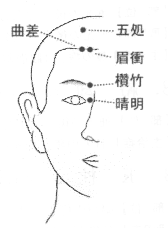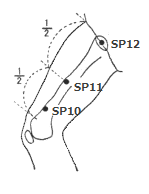Bladder Meridian(BL) for Acupuncture and Moxabustion
Bladder Meridian(BL) 足太陽膀胱経
◐ BL-1 睛明 ◐ BL-2 攅竹 ◐ BL-3 眉衝 ◐ BL-4 曲差 ◐ BL-5 五処 ◐ BL-6 承光 ◐ BL-7 通天 ◐ BL-8 絡却 ◐ BL-9 玉枕 ◐ BL-10 天柱 ◐ BL-11 大杼 ◐ BL-12 風門 ◐ BL-13 肺兪 ◐ BL-14 厥陰兪 ◐ BL-15 心兪 ◐ BL-16 督兪 ◐ BL-17 膈兪 ◐ BL-18 肝兪 ◐ BL-19 胆兪 ◐ BL-20 脾兪 ◐ BL-21 胃兪 ◐ BL-22 三焦兪 ◐ BL-23 腎兪 ◐ BL-24 気海兪 ◐ BL-25 大腸兪 ◐ BL-26 関元兪 ◐ BL-27 小腸兪 ◐ BL-28 膀胱兪 ◐ BL-29 中膂兪 ◐ BL-30 白環兪 ◐ BL-31 上髎 ◐ BL-32 次髎 ◐ BL-33 中髎 ◐ BL-34 下髎 ◐ BL-35 会陽 ◐ BL-36 承扶 ◐ BL-37 殷門 ◐ BL-38 浮郄 ◐ BL-39 陰陵泉 ◐ BL-40 委中 ◐ BL-41 附分 ◐ BL-42 魄戸 ◐ BL-43 膏肓 ◐ BL-44 神堂 ◐ BL-45 譩譆 ◐ BL-46 膈関 ◐ BL-47 魂門 ◐ BL-48 陽綱 ◐ BL-49 意舎 ◐ BL-50 胃倉 ◐ BL-51 肓門 ◐ BL-52 志室 ◐ BL-53 胞肓 ◐ BL-54 秩辺 ◐ BL-55 合陽 ◐ BL-56 承筋 ◐ BL-57 承山 ◐ BL-58 飛陽 ◐ BL-59 跗陽 ◐ BL-60 崑崙 ◐ BL-61 僕参 ◐ BL-62 申脈 ◐ BL-63 金門 ◐ BL-64 京骨 ◐ BL-65 束骨 ◐ BL-66 足通谷 ◐ BL-67 至陰

BL-1 睛明
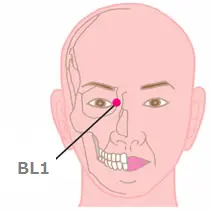
WHO : On the face, in the depression between the superomedial parts of the inner canthus of the eye and the medial wall of the orbit.
Note: When the eye is closed, BL1 is located in the depression 0.1 B-cun superior and medial to the inner canthus of the eye.
Use for : Conjunctivitis, Lacrimal duct stenosis
BL-2 攅竹

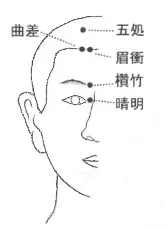
WHO : On the head, in the depression at the medial end of the eyebrow.
Note: A depression, the frontal notch, can often be palpated on the medial end of the eyebrow directly superior to BL1.
Use for : Eyestrain, Corneal opacity
BL-3 眉衝
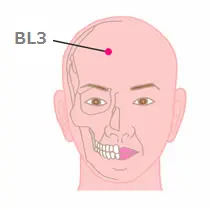
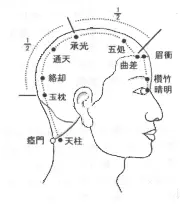
WHO : On the head, superior to the frontal notch, 0.5 B-cun superior to the anterior hairline.
Note: Midway between GV24 and BL4.
Use for : Headache, Sinus congestion
BL-4 曲差
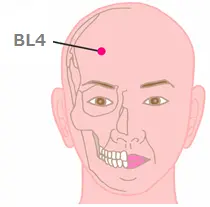
WHO : On the head, 0.5 B-cun superior to the anterior hairline, 1.5 B-cun lateral to the anterior median line.
Note: At the junction of the medial one third and lateral two thirds of the line connecting GV24 with ST8.
Use for : Sinus congestion
BL-5 五処
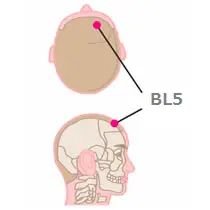
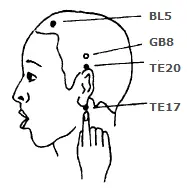
WHO : On the head, 1 B-cun superior to the anterior hairline, 1.5 B-cun lateral to the anterior median line.
Note: 0.5 B-cun superior to BL4, at the same level as GV23.
Use for : Headache, Blurred vision
BL-6 承光
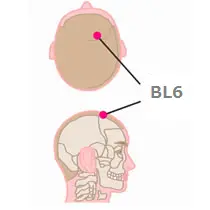
WHO : On the head, 2.5 B-cun superior to the anterior hairline, 1.5 B-cun lateral to the anterior median line.
Note: 1.5 B-cun superior to BL5. 2 B-cun superior to BL4
Use for : Headache, Vertigo, Eyes and Nose
BL-7 通天
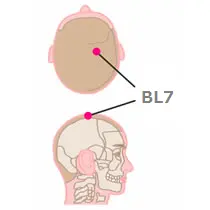
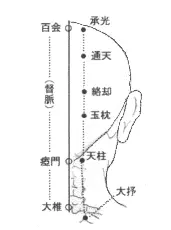
WHO : On the head, 4 B-cun superior to the anterior hairline, 1.5 B-cun lateral to the anterior median line. Note: Midway between BL6 and BL8.
Use for : Nose, Heaviness in the head, Bell’s palsy, Prevention of cerebral hemorrhage
BL-8 絡却
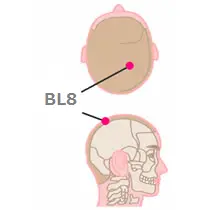
WHO : On the head, 5.5 B-cun superior to the anterior hairline, 1.5 B-cun lateral to the anterior median line.
Note: 0.5 B-cun posterior and 1.5 B-cun lateral to GV20.
Use for : Cataract, Glaucoma, Brain disease
BL-9 玉枕
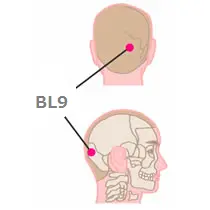
WHO : On the head, at the same level as the superior border of the external occipital protuberance, and 1.3 B-cun lateral to the posterior median line.
Note: BL9 is located at the intersection of two imaginary lines: the vertical line of the lateral border of the trapezius muscle and the horizontal line of the superior border of the external occipital protuberance. At the same level as GV17.
Use for : Headache, Eyes and Nose
BL-10 天柱

WHO : In the posterior region of the neck, at the same level as the superior border of the spinous process of the second cervical vertebra (C2), in the depression lateral to the trapezius muscle.
Use for : Headache, Ear, Eyes and Nose, Neck tension, Raise blood pressure, Partial paralysis
BL-11 大杼

WHO : In the upper back region, at the same level as the inferior border of the spinous process of the first thoracic vertebra (T1), 1.5 B-cun lateral to the posterior median line.
Use for : Respiratory disease, Cough, Bronchus
BL-12 風門
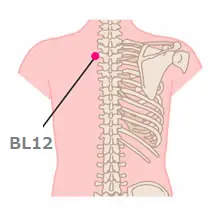
WHO : In the upper back region, at the same level as the inferior border of the spinous process of the second thoracic vertebra (T2), 1.5 Bcun lateral to the posterior median line.
Use for : Respiratory disease, Prevention and treatment of the common cold, Slight fever, Bronchitis, Stiff neck and Shoulder
BL-13 肺兪
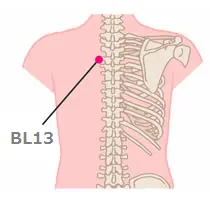
WHO : In the upper back region, at the same level as the inferior border of the spinous process of the third thoracic vertebra (T3), 1.5 B-cun lateral to the posterior median line.
Use for : Respiratory disease, Cough, Shoulder and back pain, Intercostal neuralgia
BL-14 厥陰兪
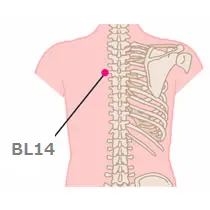
WHO : In the upper back region, at the same level as the inferior border of the spinous process of the fourth thoracic vertebra (T4), 1.5 Bcun lateral to the posterior median line.
Use for : Respiratory disease, Pleurisy, Intercostal neuralgia, Palpitation, Valvular heart disease, Upper teeth ache, Nasolacrimal duct obstruction
BL-15 心兪
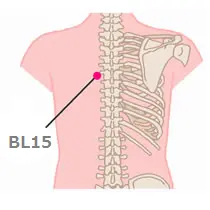
WHO : In the upper back region, at the same level as the inferior border of the spinous process of the fifth thoracic vertebra (T5), 1.5 B-cun lateral to the posterior median line.
Practical : 2 fingers from GV-11.
Use for : Heart disease, Rheumatism
BL-16 督兪
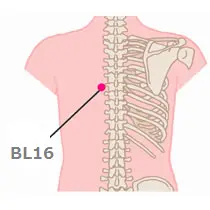
WHO : In the upper back region, level with the inferior border of the spinous process of the sixth thoracic vertebra (T6), 1.5 B-cun lateral to the posterior median line.
Practical : Between BL-15 and BL-17
Use for : Pleurisy, Pulmonary tuberculosis, Stomach cramps
BL-17 膈兪
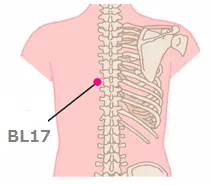
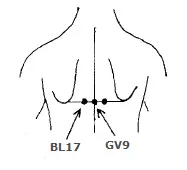
WHO : In the upper back region, at the same level as the inferior border of the spinous process of the seventh thoracic vertebra (T7), 1.5 B-cun lateral to the posterior median line.
Note: The inferior angle of the scapula is at the same level as the spinous process of the seventh thoracic vertebra.
Practical : 2 fingers from GV-9.
Use for : Esophageal stricture, Gastric atony, Gastroptosis, Hyperacidity, Insomnia, Hand numbness
BL-18 肝兪
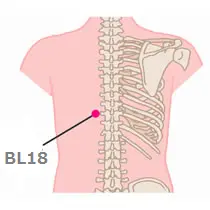
WHO : In the upper back region, at the same level as the inferior border of the spinous process of the ninth thoracic vertebra (T9), 1.5 B-cun lateral to the posterior median line.
Practical : 2 fingers from GV-8.
Use for : Eye disease, Liver disease
BL-19 胆兪

WHO : In the upper back region, at the same level as the inferior border of the spinous process of the tenth thoracic vertebra (T10), 1.5 Bcun lateral to the posterior median line.
Use for : Eye disease, Cholecystitis, Jaundice
BL-20 脾兪
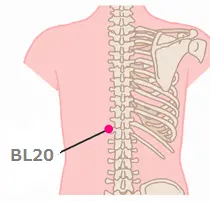
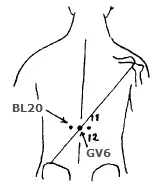
WHO : In the upper back region, at the same level as the inferior border of the spinous process of the 11th thoracic vertebra (T11), 1.5 B-cun lateral to the posterior median line.
Use for : Stomach pain, Stomach trouble, Diabetes
BL-21 胃兪

WHO : In the upper back region, at the same level as the inferior border of the spinous process of the 12th thoracic vertebra (T12), 1.5 Bcun lateral to the posterior median line.
Use for : Stomach, Gastric diseases
BL-22 三焦兪
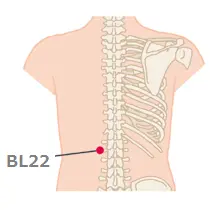
WHO : In the lumbar region, at the same level as the inferior border of the spinous process of the first lumbar vertebra (L1), 1.5 B-cun lateral to the posterior median line.
Use for : Pyelitis, Kidney diseases, Diabetes, Lower back pain
BL-23 腎兪

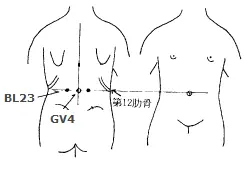
WHO : In the lumbar region, at the same level as the inferior border of the spinous process of the second lumbar vertebra (L2), 1.5 Bcun lateral to the posterior median line.
Practical : 2 fingers from GV-4. GV-4 is the back side of the navel.
Use for : Kidney diseases, Nephritis, Proteinuria, Pyelitis
BL-24 気海兪
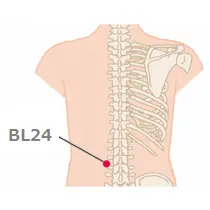
WHO : In the lumbar region, at the same level as the inferior border of the spinous process of the third lumbar vertebra (L3), 1.5 B-cun lateral to the posterior median line.
Practical : Between BL-23 and BL-25
Use for : Lower back pain, Hemorrhoid
BL-25 大腸兪
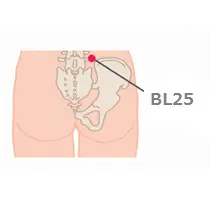
WHO : In the lumbar region, at the same level as the inferior border of the spinous process of the fourth lumbar vertebra (L4), 1.5 Bcun lateral to the posterior median line.
Practical : 2 fingers from GV-3.
Use for : Colonic diseases, Enteritis, Constipation, Diarrhea, Lower limb, Sciatica
BL-26 関元兪
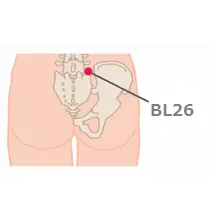
WHO : In the lumbar region, at the same level as the inferior border of the spinous process of the fifth lumbar vertebra (L5), 1.5 B-cun lateral to the posterior median line.
Practical : Between BL-25 and BL-27
Use for : Colonic diseases, Bladder spasm, Gynecological Disorders
BL-27 小腸兪

WHO : In the sacral region, at the same level as the first posterior sacral foramen, and 1.5 B-cun lateral to the median sacral crest.
Note: At the same level as BL31.
Practical : 2 fingers outside of under the first median sacral crest.
Use for : Chronic and acute rheumatism, Hemorrhoid, Diarrhea, Constipation, Sciatica, Cystitis, Irregular menstruation
BL-28 膀胱兪
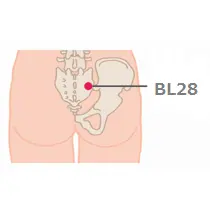
WHO : In the sacral region, at the same level as the second posterior sacral foramen, and 1.5 B-cun lateral to the median sacral crest.
Note: At the same level as BL32.
Use for : Cystitis, Gonorrhea, Sciatica( with BL23 and BL25)
BL-29 中膂兪
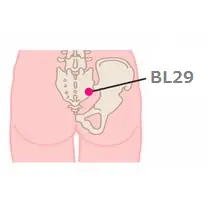
WHO : In the sacral region, at the same level as the third posterior sacral foramen, 1.5 B-cun lateral to the median sacral crest.
Note: At the same level as BL33.
Use for : Sciatica, Cystitis, Lower back pain, Dysuria
BL-30 白環兪
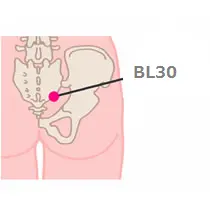
WHO : In the sacral region, at the same level as the fourth posterior sacral foramen, 1.5 B-cun lateral to the median sacral crest.
Note: 1.5 B-cun lateral to the sacral hiatus, at the same level as BL34.
Use for : Back pain, Lower back ache, Tetraplegia, Hemorrhoid
BL-31 上髎
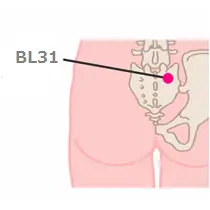
WHO : In the sacral region, in the first posterior sacral foramen.
Note: The first posterior sacral foramen is palpated in the depression, moving superiorly from BL32.
Use for : Rheumatism, Sciatica, Knee pain, Cystitis, Hemorrhoid, Low back pain, Partial paralysis, Hypertension, Endometritis, Irregular menstruation, Genital disease both for men and women
BL-32 次髎
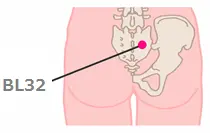
WHO : In the sacral region, in the second posterior sacral foramen.
Note: The second posterior sacral foramen is located in the depression, midway between the posterior superior iliac spine and the spinous process of the second sacral vertebra.
Use for : Bladder paralysis, Urethritis, Gynecological diseases, Genitourinary disorders, Rheumatism, Hemorrhoid, Rectal Prolapse
BL-33 中髎
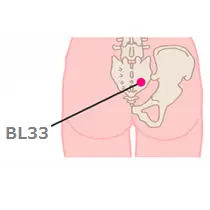
WHO : In the sacral region, in the third posterior sacral foramen.
Note: The third posterior sacral foramen is located in the first depression, moving downward from BL32.
Use for : Hemorrhoid, Cystitis
BL-34 下髎

WHO : In the sacral region, in the fourth posterior sacral foramen.
Note: The fourth posterior sacral foramen is located in the second depression, moving downward from BL32, at the same level as the sacral hiatus.
Use for : Hemorrhoid, Rectal Prolapse, Urethritis, Acute proctitis, Impotence, Oneirogmus
BL-35 会陽
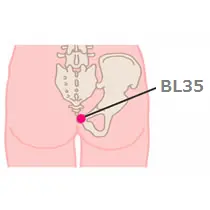
WHO : In the buttock region, 0.5 B-cun lateral to the extremity of the coccyx.
Note: The subject may be in prone position or knee-chest position. BL35 is located at the soft depression lateral to the extremity of the coccyx.
Use for : Hemorrhoidal bleeding, Hemorrhoid, Abdominal hernias
BL-36 承扶
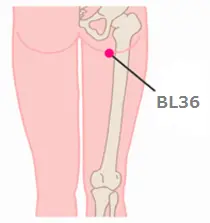
WHO : In the buttock region, at the midpoint of the gluteal fold.
Use for : Pain and coldness of the back-hipinner-thigh, Hemorrhoidal bleeding and swelling, Constipation, Difficulty with urination flow(Benign prostatic hyperplasia),
BL-37 殷門
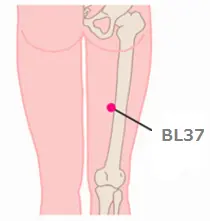
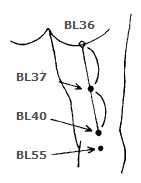
WHO : On the posterior aspect of the thigh, between the biceps femoris and the semitendinosus muscles, 6 B-cun inferior to the gluteal fold.
Note 1: In the prone position, the semitendinosus and the biceps femoris muscles are more distinct when the knee is flexed against resistance. In addition, it is easier to find the two muscles with internal and external rotation of the hip.
Note 2: 1 B-cun superior to the midpoint of the line connecting BL36 with BL40.
Use for : Sciatica
BL-38 浮郄
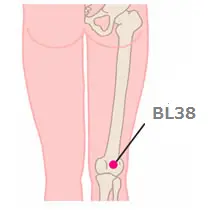
WHO : On the posterior aspect of the knee, just medial to the biceps femoris tendon, 1 Bcun proximal to the popliteal crease.
Note: With the knee in slight flexion, BL38 is located medial to the biceps femoris tendon, 1 B-cun proximal to BL39.
Use for : Knee pain, Fibula neuralgia
BL-39 委陽
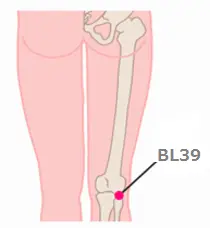
WHO : On the posterolateral aspect of the knee, just medial to the biceps femoris tendon in the popliteal crease.
Note: The biceps femoris tendon is more prominent when the knee is slightly flexed.
Use for : Knee pain, Fibula neuralgia, Paralysis
BL-40 委中
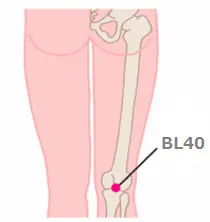
WHO : On the posterior aspect of the knee, at the midpoint of the popliteal crease.
Use for : Sciatica, Knee pain, Rheumatism, Lower back pain, Headache
BL-41 附分
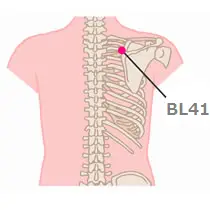
WHO : In the upper back region, at the same level as the inferior border of the spinous process of the second thoracic vertebra (T2), 3 B-cun lateral to the posterior median line.
Note: BL41 and BL12 are located at the same level as the inferior border of the spinous process of the second thoracic vertebra (T2).
Use for : Shoulder pain, Back pain, Brachialgia
BL-42 魄戸
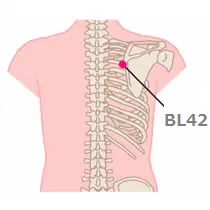
WHO : In the upper back region, at the same level as the inferior border of the spinous process of the third thoracic vertebra (T3), 3 B-cun lateral to the posterior median line.
Note: BL42, BL13 and GV12 are located at the same level as the inferior border of the third thoracic vertebra (T3).
Use for : Backache, Phlyctenule, Scrofula, Pulmonary tuberculosis, Respiratory diseases
*魄というのは肺臓の精気の意味
BL-43 膏肓

WHO : In the upper back region, at the same level as the inferior border of the spinous process of the fourth thoracic vertebra (T4), 3 B-cun lateral to the posterior median line.
Note: BL43 and BL14 are located at the same level as the inferior border of the spinous process of the fourth thoracic vertebra (T4).
Use for : Night sweats, Pulmonary tuberculosis, Heart diseases, Nocturnal emission, Amnesia, Gastric diseases, Enhance the vital energy, Trigeminal neuralgia(with GV11, BL15 and BL42), Stiff neck and shoulder(with GB21 and SI14)
*Acu points of the back is effective when used in conjunction with the point of the other points of the back.
*ケンビキのこと
BL-44 神堂
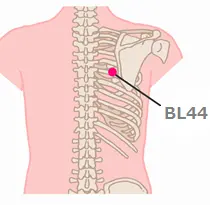
WHO : In the upper back region, at the same level as the inferior border of the spinous process of the fifth thoracic vertebra (T5), 3 B-cun lateral to the posterior median line.
Note: BL44, BL15 and GV11 are located at the same level as the inferior border of the spinous process of the fifth thoracic vertebra (T5).
Use for : Shoulder pain, Back pain, Twitching of the back, Stiffness of the back, Intercostal neuralgia
*神は心に蔵する精気という意味。神堂は心臓の精気が座する宮殿へ通じる穴ということ
BL-45 譩譆
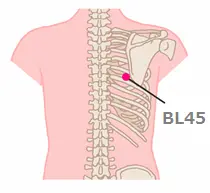
WHO : In the upper back region, at the same level as the inferior border of the spinous process of the sixth thoracic vertebra (T6), 3 B-cun lateral to the posterior median line.
Note: BL45, BL16 and GV10 are located at the same level as the inferior border of the spinous process of the sixth thoracic vertebra (T6).
Use for : Fever and Shaking chills, Insomnia, Intercostal neuralgia, Chest Pain, Rheumatism
*譩がおくび、譆が声を発するという意味。この穴を指で強く圧するとウッと声を発する。押すと譩譆す。
BL-46 膈関
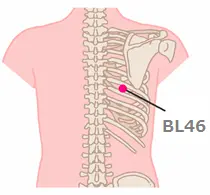
WHO : In the upper back region, at the same level as the inferior border of the spinous process of the seventh thoracic vertebra (T7), 3 B-cun lateral to the posterior median line.
Note: BL 46, BL17 and GV9 are located at the same level as the inferior border of the spinous process of the seventh thoracic vertebra (T7).
Use for : Esophageal spasm, Back pain
*古くは、膈の病とは胃癌や食道狭窄。
BL-47 魂門
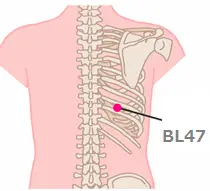
WHO : In the upper back region, at the same level as the inferior border of the spinous process of the ninth thoracic vertebra (T9), 3 B-cun lateral to the posterior median line.
Note: BL47, BL18 and GV8 are located at the same level as the inferior border of the spinous process of the ninth thoracic vertebra (T9).
Use for : Liver disease, Stomach cramps
*回虫による腹痛は魂門から膈関、陽綱に圧痛あり。
BL-48 陽綱
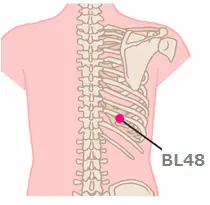
WHO : In the upper back region, at the same level as the inferior border of the spinous process of the tenth thoracic vertebra (T10), 3 B-cun lateral to the posterior median line.
Note: BL48, BL19 and GV7 are located at the same level as the inferior border of the spinous process of the tenth thoracic vertebra (T10).
Use for : Liver disease, Cholelithiasis, Stomach cramps, Diarrhea, Diabetes, Loss of appetite, 腹張
BL-49 意舎
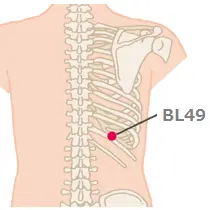
WHO : In the upper back region, at the same level as the inferior border of the spinous process of the 11th thoracic vertebra (T11), 3 B-cun lateral to the posterior median line.
Note: BL49, BL20 and GV6 are located at the same level as the inferior border of thespinous process of the 11th thoracic vertebra (T11).
Use for : Stomach cramps, Gallstone pain
BL-50 胃倉
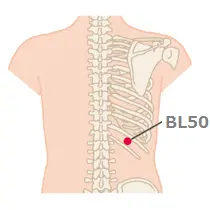
WHO : In the upper back region, at the same level as the inferior border of the spinous process of the 12th thoracic vertebra (T12), 3 B-cun lateral to the posterior median line.
Note: BL50 and BL21 are located at the same level as the inferior border of the spinous process of the 12th thoracic vertebra (T12).
Use for : Stomach cramps, Gallstone pain
BL-51 肓門

WHO : In the lumbar region, at the same level as the inferior border of the spinous process of the first lumbar vertebra (L1), 3 B-cun lateral to the posterior median line.
Note: BL51, BL22 and GV5 are located at the same level as the inferior border of the spinous process of the first lumbar vertebra (L1).
Use for :
BL-52 志室
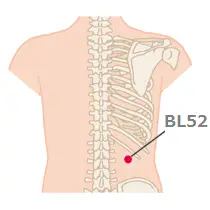
WHO : In the lumbar region, at the same level as the inferior border of the spinous process of the second lumbar vertebra (L2), 3 Bcun lateral to the posterior median line.
Note: BL52, BL23 and GV4 are located at the same level as the inferior border of the spinous process of the second lumbar vertebra (L2).
Use for :
BL-53 胞肓
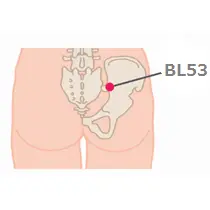
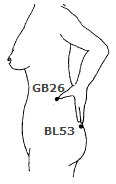
WHO : In the buttock region, at the same level as the second posterior sacral foramen, 3 Bcun lateral to the median sacral crest. Note: BL53, BL28 and BL32 are located at the same level as the second posterior sacral foramen.
Use for :
BL-54 秩辺

WHO : In the buttock region, at the same level as the fourth posterior sacral foramen, 3 Bcun lateral to the median sacral crest.
Note: 3 B-cun lateral to the sacral hiatus, at the same level as BL 30.
Use for :
BL-55 合陽
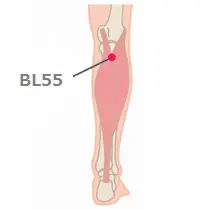
WHO : On the posterior aspect of the leg, between the lateral head and medial head of the gastrocnemius muscle, 2 B-cun distal to the popliteal crease.
Note: 2 B-cun distal to BL40, on the line connecting BL40 with BL57.
Use for :
BL-56 承筋
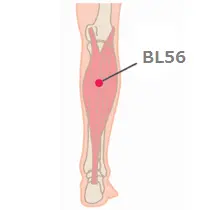
WHO : On the posterior aspect of the leg, between the two muscle bellies of the gastrocnemius muscle, 5 B-cun distal to the popliteal crease.
Note: Midway between BL55 and BL57.
Use for :
BL-57 承山
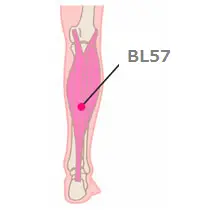
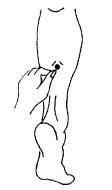
WHO : On the posterior aspect of the leg, at the connecting point of the calcaneal tendon with the two muscle bellies of the gastrocnemius muscle.
Note: With the leg stretched (plantar flexion) or the heel up, BL57 is located at the sharp angled depression inferior to the muscle belly of the gastrocnemius muscle. The two heads of the gastrocnemius muscle are separated to make a lambda shape (Λ).
Use for :
BL-58 飛陽
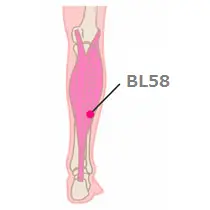
WHO : On the posterolateral aspect of the leg, between the inferior border of the lateral head of the gastrocnemius muscle and the calcaneal tendon, at the same level as 7 Bcun proximal to BL60.
Note: BL58 is located 1 B-cun lateral and distal to BL57, proximal to BL60.
Use for :
BL-59 跗陽
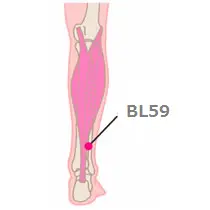
WHO : On the posterolateral aspect of the leg, between the fibula and the calcaneal tendon, at the same level as 3 B-cun proximal to BL60.
Use for :
BL-60 崑崙
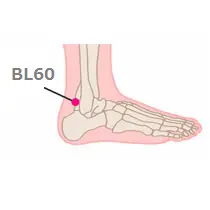
WHO : On the posterolateral aspect of the ankle, in the depression between the prominence of the lateral malleolus and the calcaneal tendon.
Use for :
BL-61 僕参
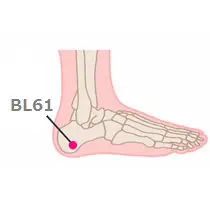
WHO : On the lateral aspect of the foot, distal to BL60, lateral to the calcaneus, at the border between the red and white flesh.
Use for :
BL-62 申脈
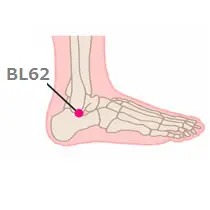
WHO : On the lateral aspect of the foot, directly inferior to the prominence of the lateral malleolus, in the depression between the inferior border of the lateral malleolus and the calcaneus.
Note: BL62 is located in the depression distal to the inferior border of the lateral malleolus. The corresponding medial acupuncture point to BL 62 is KI6.
Use for :
BL-63 金門
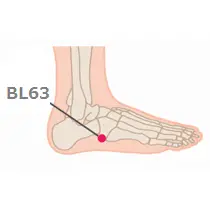
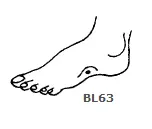
WHO : On the dorsum of the foot, distal to the anterior border of the lateral malleolus, posterior to the tuberosity of the fifth metatarsal bone, in the depression inferior to the cuboid bone.
Use for :
BL-64 京骨

WHO : On the lateral aspect of the foot, distal to the tuberosity of the fifth metatarsal bone, at the border between the red and white flesh.
Note: The tuberosity of the fifth metatarsal bone is located approximately midway between the heel and the fifth metatarsophalangeal joint.
Use for :
BL-65 束骨
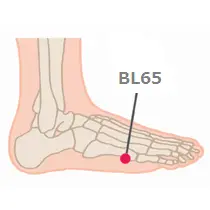
WHO : On the lateral aspect of the foot, in the depression proximal to the fifth metatarsophalangeal joint, at the border between the red and white flesh.
Use for :
BL-66 足通谷
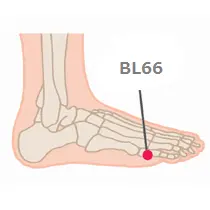
WHO : On the little toe, in the depression distal and lateral to the fifth metatarsophalangeal joint, at the border between the red and white flesh.
Use for :
BL-67 至陰
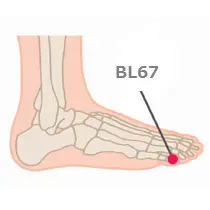
WHO : On the little toe, lateral to the distal phalanx, 0.1 F-cun proximal to the lateral corner of the toenail; at the intersection of the vertical line of the lateral side of the nail and the horizontal line of the base of the toenail.
Use for :
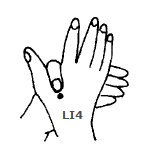
Large Intestine (LI) Meridian and Acu points
Large Intestine Meridian(LI) for Acupuncture and Moxabustion 手陽明大腸経

